From the Cave Man to Craftsmanship; a gendered conversation:
The case of ethnographic displays in Zambian Museums
Zambia, like most African countries in Southern Africa, was under British colonial rule for 74 years, during which time the British promoted and imposed their way of seeing the world.[1] Museums as public forums were one of the platforms through which the colonialists peddled this imposition.[2] The histories of ethnographic collections bear the brunt of an all-male face from the cave man in prehistory, the handyman in history to craftsmanship in ethnography. Even female dominated spaces and systems could not escape this projection. This paper therefore addresses how colonialism influenced the generation of knowledge in Zambian museums to an all-male projection, even in spaces that were dominated by women such as production, rulership and craftsmanship; a situation that has prevailed to date. Male dominated narratives in the prehistory display will be drawn from Livingstone Museum, Lusaka National Museum and Moto Moto Museum, which take more or less the same approach to the story of early man in Zambia, covering the Stone Age, Iron Age and the Bantu Migration. On rulership, the paper will use the Moto Moto Museum and Livingstone Museum displays that have the same approach. On craftsmanship, the paper will use Choma Museum and Moto Moto Museum displays as examples.
The Caveman: Early man’s technology and development
The first part of museum exhibitions in Zambia is the prehistory section. What is notable of this section’s display at the Livingstone Museum, Lusaka National Museum and Moto Moto Museum are the tools that dominate each technological phase and the associated economic activity of the industrial phase of human development. The tools such as the hand-axe associated with chopping wood, the bone tools associated with hunting, the blade-like points associated with wood working and hunting, the flake tools associated with the invention of the bow and arrow, stone hammers and the use of fire associated with hunting and keeping the wild animals away, dominate the narrative of the displays. These tools and activities conjure up masculine type of technologies and economic activities. The feminine kind of technologies, such as the bored stone, the grinding stone and the use of fire for food processing – implements and activities that bring out feminine roles and tools in today’s world – take a back stage. This kind of narrative and the material culture celebrated in each stage leaves no room to imagine the early inhabitant of this country being anything else but a cave man. It is hard with this kind of display to imagine a cave woman or economic activities and significant technological inventions that can be attributed to women.
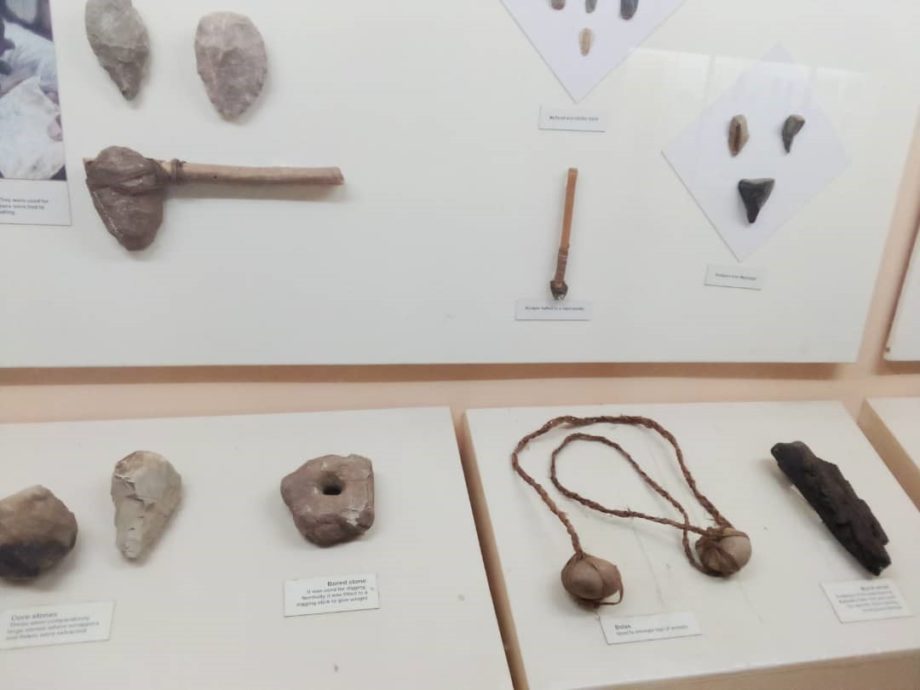
From top left to bottom right: hand axe for chopping, scrappers for scrapping skins of animals, pick used for chopping and digging, bored stone used as weight for digging, bolas used for hunting animals and burned wood as confirmation of the use of fire. (Moto Moto Museum, prehistory exhibition).
The Stone Age period is also associated with Rock Art paintings, dating back to 8,000 years ago. The rock art paintings exhibitions concentrate on naturalistic paintings that emphasize the hunting rituals that portray men’s activities and less on schematic art. The exhibitions do not demonstrate how the symbols of schematic art is used by today’s women and how it has impacted on their actions, spirituality, experiences and understandings across ancient history.[3] Over eighty symbols linked to the schematic rock art are still used in twenty first century Zambia among the Bemba and Chewa in female initiation ceremonies. They are used, among other things, to spiritually transform girls to women, bolstering female reproductive knowledge and fertility.[4] Although the female initiation ceremonies are exhibited, the linkage between the schematic rock art and the current female ceremonies is not there. Significant among the schematic symbols that is still used today is the ‘mushintililo’, a reproduction of the bored stone that is used today in the final observance of the female ceremonies.[5] The ‘mushintililo’ which is also known as ‘mutual understanding’ celebrates women’s knowledge and offers a possible direct linkage not only to the stone age rock art painters but also the stone age tool makers.
The Handyman
The Iron Age which, as a period that preluded to modern man in Zambia, emphasizes the use of fire by men in iron smelting. At Moto Moto Museum and Lusaka National Museum, a life size iron smelter dominates the exhibition space of the Iron Age era. The use of fire is never linked to the position of women in relation to the control and ownership of the hearth and fire common in Bantu societies, which was crucial in terms of women’s authority at household level.[6] The absence of this kind of narrative gives room for foreign interpretation of women’s position at the household level in the Zambian society context.
Iron smelter display is complimented with a display of different iron implements to show the craftsmanship of the people that worked the iron. This goes together with the political organization that introduces Chieftainship to Zambia. It is safe to say that since the iron working is a man’s domain, this part of the exhibition celebrates men’s work and their skill. It also brings the notion that iron working brought about Chieftainship in Zambia and as such gives a male attribute to Chieftainship.
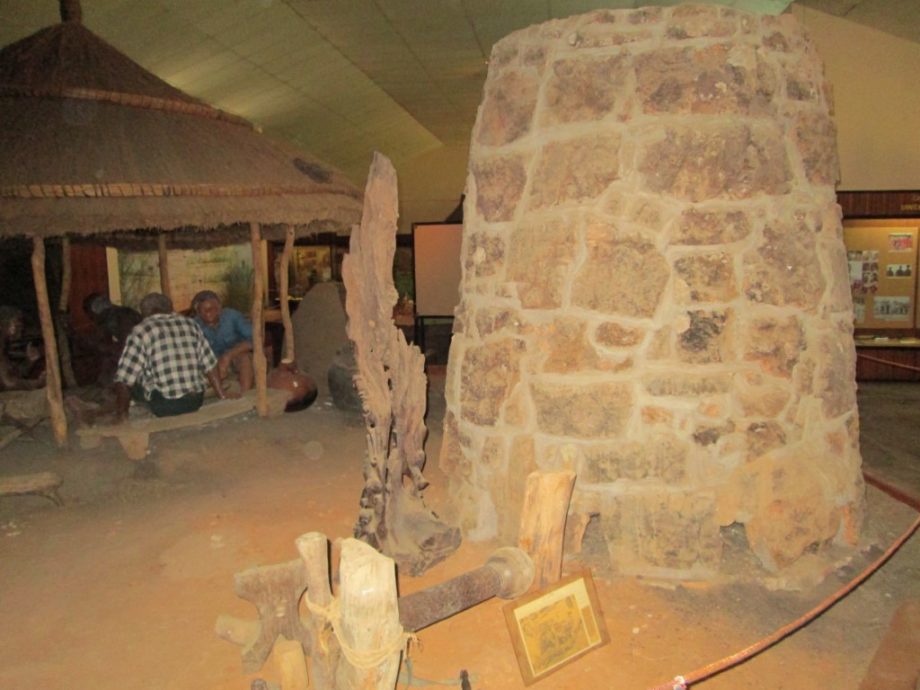
‘Ilungu’, the iron smelting furnace in Moto Moto Museum’s ethnography gallery. In the background is ‘Insaka’, the men’s traditional shelter, where a demonstration of iron smithing is displayed. (Moto Moto Museum, Ethnography Gallery).
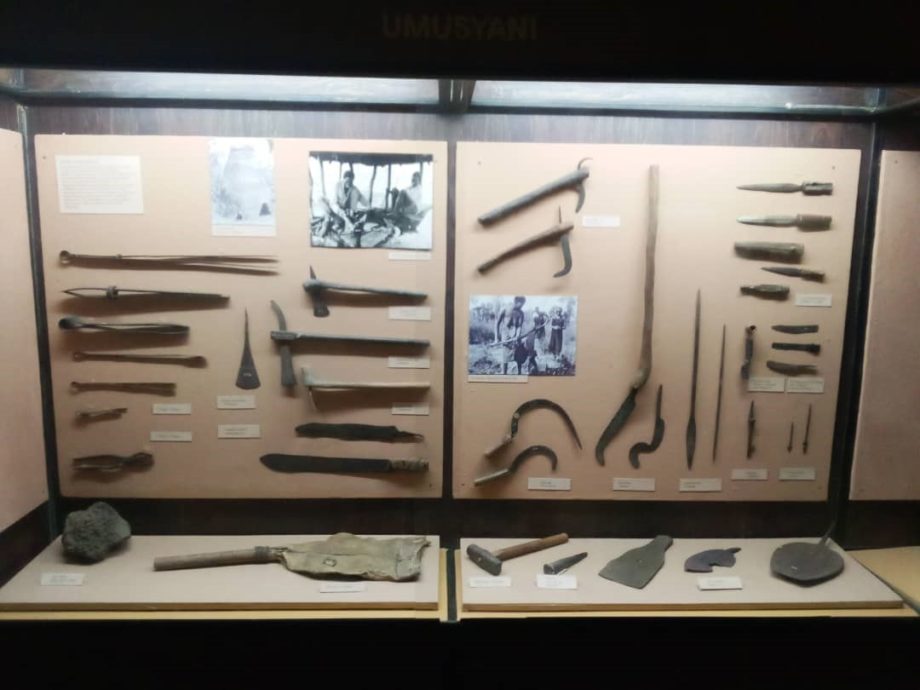
A display of different iron implements produced from ‘ilungu’ and ‘insaka’ (Moto Moto Museum, Ethnography Gallery).
What is also absent in this part of the exhibition in both museums above is the role of pottery in the political and spiritual development of Zambian Society. The exhibitions fail to point to the variation in the timeline between iron technology, a predominantly male technology and pottery, a predominantly female technology. The timeline shows that pottery is an older technology, dating as far back as 9400 BCE while iron technology emerged several millennia latter around 1800 BCE.[7] The exhibitions do not emphasize the historic tradition, the material science, spiritual tenets, and the complexities of the technological processes involved that the woman technician had to observe to make a pot. Neither do the exhibitions try to show the connectivity of the name of the potter in most Bantu speaking languages, to the local name of God. Most Bantu languages, those of Zambia included, take on a variety of a social imagery verbs for the Creator’s action to create humans i.e. ‘Bumba’, ‘Mumba’ or ‘Mumbi ’ as the name of makers of pots, showing the possible connection to women’s spiritual position and the overall position of women in traditional Bantu societies.[8] The emphasis of Iron working in the Iron age era that is associated with political organizations obscures pottery which exists side by side with iron smelting in this era and in turn makes political history seem masculine and the role of pottery in political development absent both in the language used and in the visual presentation. Since women are associated with pottery and not iron, their presence in technology, science and politics is not as visible as in the Iron working that is associated with man.
It is not surprising therefore that the History section in all museums displaying traditional political organizations, which is a prelude to today’s politics in Zambia, only shows material culture attributed to traditional rulership that is associated with male chiefs. The exhibitions also lists and show only male chiefs even though precolonial Zambia had just as many female chiefs and was 80 percent matrilineal and matriarchal. Therefore, handymanship in the form of iron working, science and technology, nation-building, politics and governance is presented in a way that associates it with masculinity and obscures women.
The craftsmanship
At Choma museum, the main women-related craft in the craftsmanship category is basketry. However, the emphasis on basketry in the exhibitions is utility and not other values such as art or spirituality, which are also values associated with the baskets.
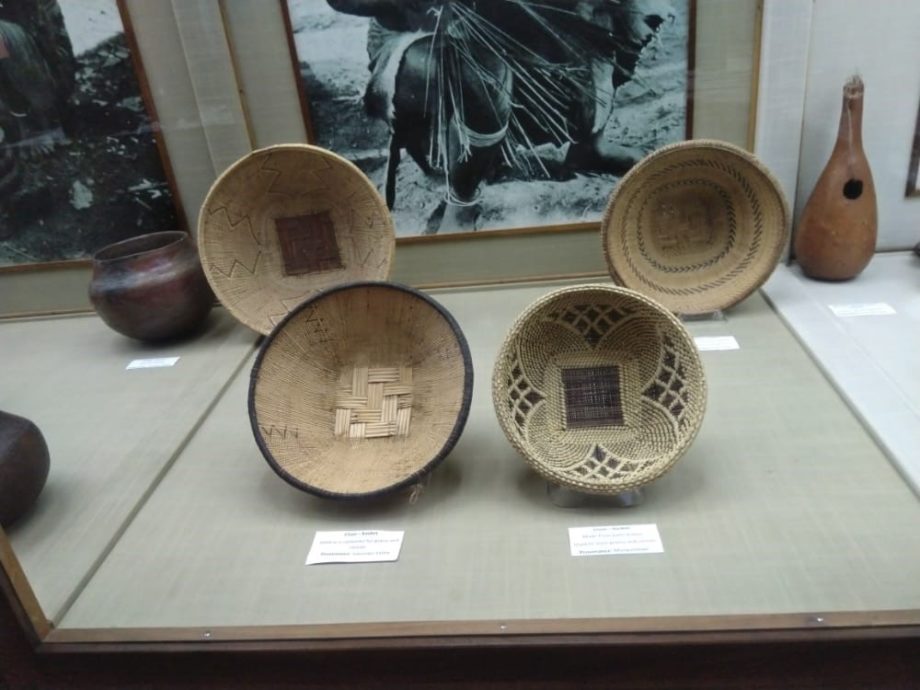
Choma Museum display on Tonga baskets. The focus of this display is utility and provenance.
The display fails to capture the use of these baskets in the documentation of the spirituality, historic and artistic narratives of the Tonga women basket weavers. These narratives which are part of the tradition of basket weaving and which indicate women’s position in Tonga culture and history are missing in the exhibition narratives.
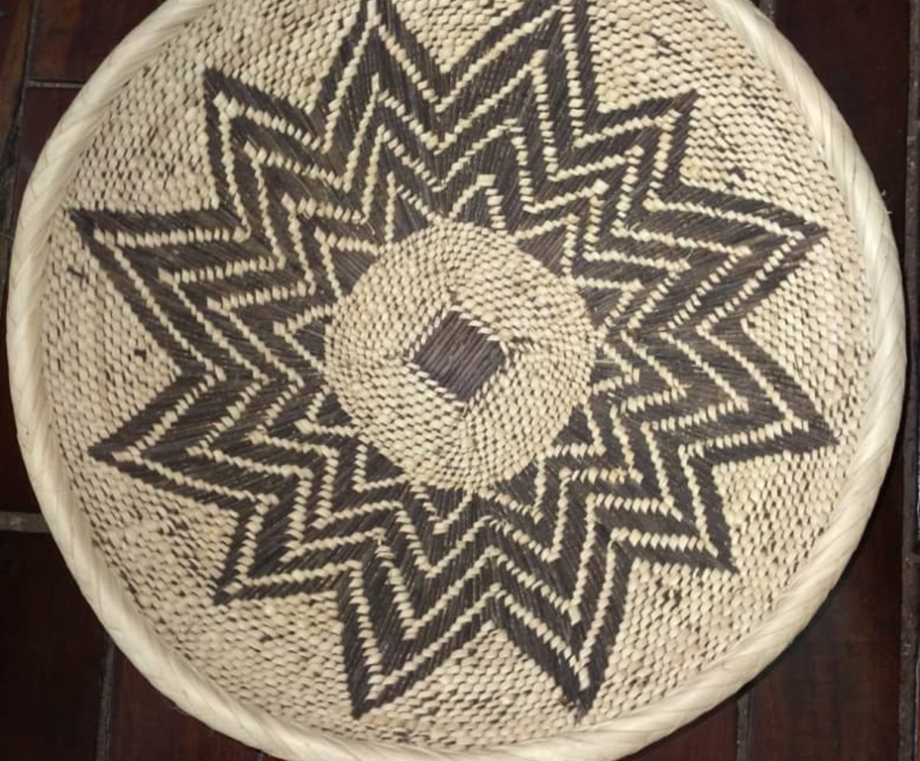
Basket patterns like ‘Nyenyezi’, the star, are a reflection of the celestial bodies that include the moon and the sun which are strongly linked to womanhood in the Tonga tradition, representing beauty, reproduction and spirituality.[9]
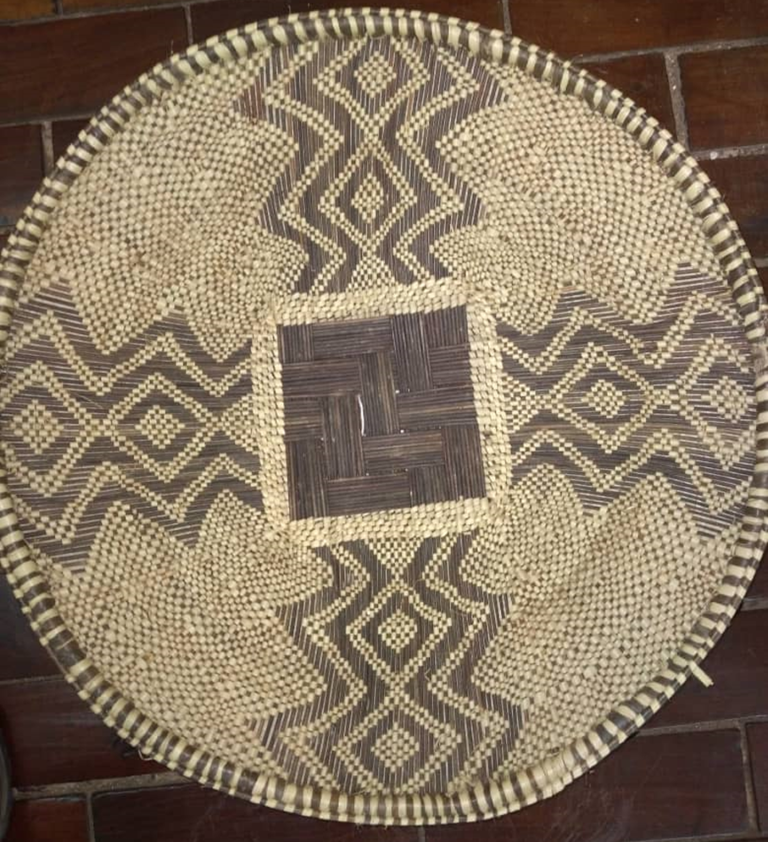
‘Chibize’, the Zebra, tells the story of nature and the central position of animal life in Tonga culture. This is demonstrated in most Tonga clan names that are also names of animals, such as Mpongo (the goat), Mudenda (the elephant), Sulwe (the hare) etc. Most importantly, clan names are inherited only through female relatives, i.e. a child will inherit their clan name through the mother’s lineage.[11]
At Moto Moto Museum, a display on Mbusa, teaching aids in the female initiation ceremonies, gives a generalized and oversimplified explanations of their function. It is devoid of the scientific, psychological and environmental background in which the Mbusa is created. This approach devalues the knowledge of the object as well as the maker, making women’s knowledge systems to be regarded as not worth being part of accepted bodies of knowledge. Thus, the craftsmanship makes Mbusa not to be appreciated as a part of scientific knowledge systems that understand psychological, environmental and health issues.[10]
The examples in this paper show how most Zambian museums, influenced by their first curators during colonial times, emphasize the role of men and their influence on society, while women’s narratives and women’s influences on society are either missing or obscured by men’s activities. The patriarchal biased narrative has continued after the colonial period, were post-colonial museum curators have taken up and maintained the male perspective. This is the case even where oral history and other forms of evidence such as archaeology and language demonstrate otherwise. Very few women-centered narratives make it to the museum public displays.
Victoria Phiri Chitungu is a researcher in cultural history and has worked for the National Museums Board of Zambia for more than 20 years, as a researcher and also as a Director. Currently she is a Curator at Choma Museum and Crafts Centre.
About the DCNtR Debate #1: It has long been accepted that colonialism had a distinctive epistemic dimension, which was upheld by disciplines such as social anthropology and other knowledge-making projects. Under this colonial episteme, people and human experiences were hierarchically classified according to racial categories and ethnography and ethnographic collecting were key components in these processes. However, the colonial regime did not only rely on race as an organising category, but also on gender. The first debate in the DCNtR Debates series tackles this question with seven contributions from around the world which explore the relationship between the gender of the collector, the gender of those collected from and consequences of these gendered practices of collecting for the epistemic practices of display in today’s museums.
Footnotes
[i] J.D. Fage, ‘The Development of African Historiography’, in KI-Zerbo, J. (ed), UNESCO General History of Africa, 1 : Methodology and African Prehistory (California: Heinemann, 1981) pp 30-35.
[2] D.W. Phillipson, ‘The Early and Middle Stone Ages’ in B. Fagan, A Short History of Zambia (Nairobi: Oxford University Press, 1968), pp. 48-57.
[3] Catherine Cymone Fourshey, Rhonda M. Gonzales, Christine Saidi, Bantu Africa. 3500 BCE TO PRESENT: Oxford, Oxford University Press, 2018, p. 54.
[4]Catherine Cymone Fourshey, Rhonda M. Gonzales, Christine Saidi, Bantu Africa. 3500 BCE TO PRESENT: Oxford, Oxford University Press, 2018 , p. 53 and Christine Saidi, Women’s Authority and Society in Early East-Central Africa, University of Rochester Press, 2010, p. 108.
[5]Christine Saidi, Women’s Authority and Society in Early East –Central Africa, University of Rochester Press, 2010, p. 111.
[6] Christine Saidi, Women’s Authority and Society in Early East –Central Africa, University of Rochester Press, 2010
[7]Catherine Cymone Fourshey, Rhonda M. Gonzales, Christine Saidi, Bantu Africa. 3500 BCE TO PRESENT: Oxford, Oxford University Press, 2018, p. 126.
[8] Catherine Cymone Fourshey, Rhonda M. Gonzales, Christine Saidi, Bantu Africa.. 3500 BCE TO PRESENT: Oxford, Oxford University Press, 2018, pp. 1-28.
[9] Interview with Siampondo basket makers, Gwembe, Gwembe workshop, 25th October 2020.
[10] Victoria Chitungu, Mbusa and Vilengo in the Mitigation of HIV/AIDS in Zambia, Unza Press, 2012, p. iii.
[11] Interview with Siampondo basket makers, Gwembe, Gwembe workshop, 25th October 2020.































